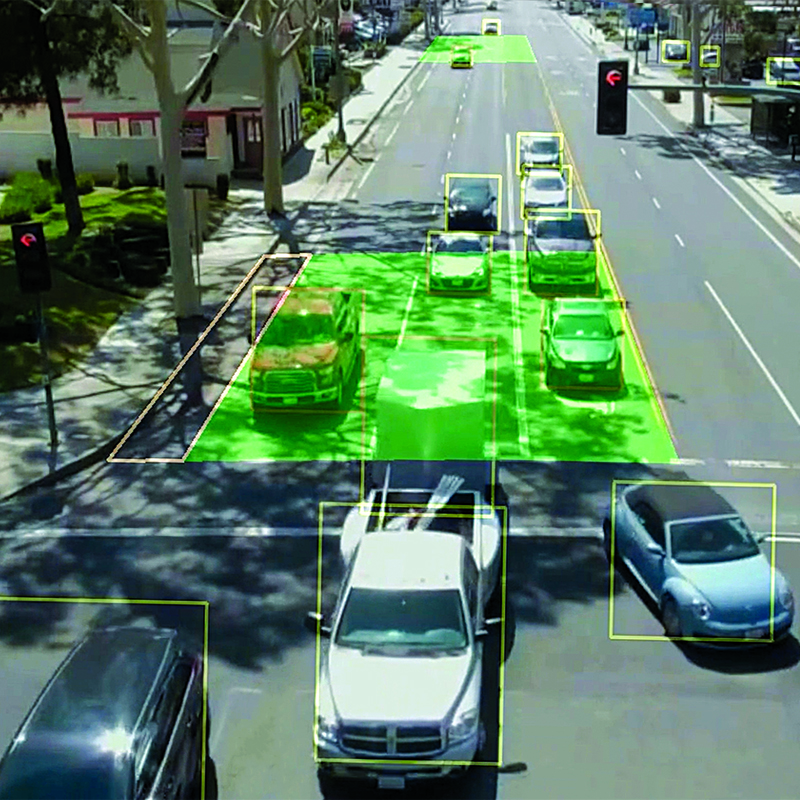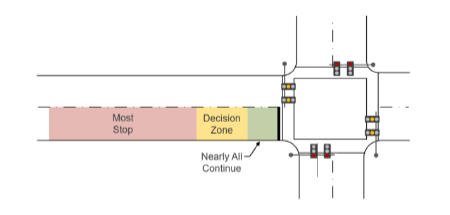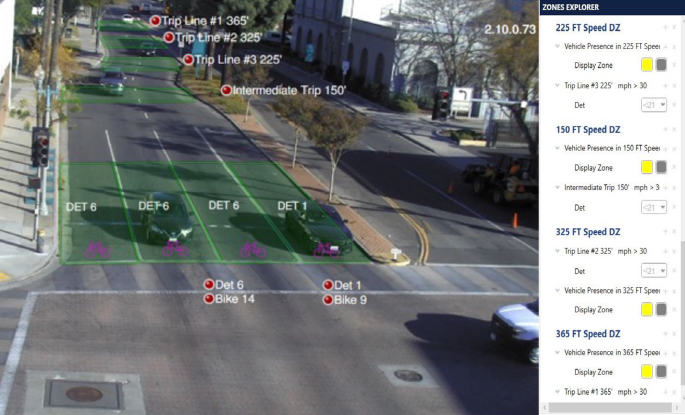Safer Intersections with Dilemma Zone Protection and Traffic Responsive Systems
Modern intersections are evolving to meet the needs of both growing populations and modal shifts to more sustainable transportation options. This often results in larger and busier intersections. With the rise of smart mobility and Vision Zero initiatives, cities are turning to intelligent technologies to provide dilemma zone protection and traffic responsive systems to mitigate conflicts. Together, these systems can improve traffic flow and protect Vulnerable Roadway Users (VRUs).

The Intersection Safety Challenge
According to the Federal Highway Administration (FHWA) and National Highway Traffic Safety Administration (NHTSA), about half of traffic collisions occur at intersections. Sadly, approximately 25% of all traffic fatalities and 50% of all injuries in the U.S. occur due to collisions at highway intersections. Signalized intersections are hotspots for these conflicts. The risk increases for collisions and injuries at high-speed approaches. Drivers often face a split-second decision when the light turns yellow to stop abruptly and risk a rear-end collision or proceed and risk running a red light and risk an angle vehicle collision or VRU conflict. This moment of indecision before the intersection is known as the dilemma zone, and it’s a key factor in collisions at signalized intersections.
What Dilemma Zone Protection Is
The dilemma zone, or “decision zone,” is the most critical point in ensuring safe passage of a vehicle approaching an intersection. Dilemma zone protection and traffic-responsive systems can significantly enhance intersection safety by reducing driver uncertainty or indecision and adapting to real-time traffic conditions.
Dilemma zone protection utilizes sensors and advanced controller software to detect vehicles at risk of running a red light or making a sudden stop, thereby extending the green signal or preventing all-red-light phases to prevent collisions. Meanwhile, traffic-responsive systems adjust signal timing based on actual demand, minimizing driver indecision and improving traffic flow. Together, these technologies focus on a critical component of Vision Zero: intersection collision avoidance. These innovations are not just about efficiency. Vision Zero is about saving lives
Understanding Type I vs. Type II Dilemma Zones
Type I Dilemma Zones
According to Gazis, Herman, and Maradudin’s original 1960s dilemma zone research, a dilemma zone is defined as the area ahead of a signalized intersection in which a driver is unable to stop safely before the stop bar or proceed through the intersection before the signal turns red. Today, this is what is known as the “Type I” dilemma zone. This definition is largely tied to signal timing. Type 1 dilemma zone emphasizes the yellow- and red-light clearance intervals. If the interval is too short, it does not allow drivers to safely stop or proceed through the intersection.
Type II Dilemma Zones
In the 1970s, Zeeger and Deen’s research considered distances relative to vehicle velocity and driver behavior. This is known as the “Type II” dilemma zone, or often referred to as the “decision zone” – consisting of the area in which a driver decides to either stop or proceed through the intersection before the signal turns red. The Type II dilemma zone is a more dynamic definition. It refers to the distance beyond which 90% of all drivers would stop if presented with a yellow signal, or about five seconds of travel time.

From here, “dilemma zone” will refer to the Type II dilemma zone. By breaking down the dilemma zone into physics and driver behavior, dilemma zone protection strategies can be effectively applied through deploying multi-tasking detection sensors and using signal control logic to reduce conflicts at the intersection.
The Signal Timing Manual Second Edition (STM2), which provides trend-based guidance from previous decision zone studies, indicates the decision zone usually exists between 5.5 and 2.5 seconds of travel time from the stop bar. The accompanying table quantifies these values in stop bar distance, dictated by various common approach speeds. This travel time-based definition is the simplest quantification of the decision zone, but it should be used with caution, as most of the factors involved in the decision zone are human.
| Approach/Vehicle Speed (Miles Per Hour) | Beginning of Decision Zone (5.5 Seconds from Stop Bar) | End of Decision Zone (2.5 Seconds from Stop Bar) |
| 35 | 285 feet | 125 feet |
| 40 | 325 feet | 145 feet |
| 45 | 365 feet | 165 feet |
| 50 | 405 feet | 180 feet |
| 55 | 445 feet | 200 feet |
How Dilemma Zone Protection Works
Using radar, HD video, or in-ground detection, sensor systems can provide new levels of situational awareness. They can detect and classify several vehicles approaching the intersection, as well as VRUs. Leveraging next-generation technologies and AI-powered applications, sensors can accurately determine vehicle speed, trajectory, and track multiple objects in a dilemma zone. Communicating with the traffic controller, an integrated dilemma zone protection system can:
- Extend the green light to allow safe passage
- Trigger an all-red extension to prevent cross-traffic conflicts
- Delay phase termination until the vehicle clears the intersection
These dynamic traffic control capabilities help reduce both angle collisions (from red-light running) with cross traffic, rear-end crashes (from sudden stops), and conflicts with VRUs.
Dynamic Dilemma Zone Strategies Require Leading-Edge Solutions
Advanced sensor systems like Econolite’s EPIQ RADAR™ and Autoscope® line of HD video cameras combined with controllers powered by Econolite’s breakthrough EOS firmware, offer innovative solutions for dilemma zone protection. Additional features enabled in the Econolite’s sensors provides more intelligent green extension or red extension capabilities as required.
Advance detection zones should be created as “motion” zones to let various conditional elements control the zone’s output. One such conditional element lets users identify a specific “ETA point”—destination point—for vehicles passing over the motion zone. A specific output can then be enabled from that zone whenever a vehicle at the leading edge of the motion zone reaches the ETA point within a given minimum and maximum number of seconds.

Traffic Responsive Signal Control: Adapting to Real-Time Demand
Cities can significantly increase safety and reduce collisions by implementing traffic responsive signal control systems. These systems adjust signal timing based on real-time traffic data, selecting from pre-programmed timing plans that best match current conditions.
Unlike fixed-time signals, which operate on static schedules, traffic-responsive systems use sensors to gather traffic data and apply analytics to quickly:
- Monitor vehicle volumes and speeds
- Detect pedestrian activity
- Respond to incidents or congestion
- Prioritize movements dynamically
Dynamic Adjustments Equals Safer, Smoother Traffic Flow
Modern traffic responsive signal systems dynamically adjust to real-time conditions, offering a range of safety and operational benefits. Below are some primary ways these systems contribute to safer, smoother intersections:
- Fewer Stops and Sudden Braking: By matching signal timing to actual demand, traffic-responsive systems reduce unnecessary stops and abrupt deceleration, which are key contributors to rear-end collisions.
- Reduced Red-Light Running: Improved coordination and timing reduce driver indecision and the likelihood of encountering unexpected yellow phases. Thus, minimizing red-light violations.
- Priority for All Modes: Responsive systems can prioritize transit, emergency vehicles, bicycles, and pedestrians, enhancing safety and equity.
- Real-Time Incident Response: When crashes or congestion occur, traffic responsive systems can shift timing plans instantly, rerouting traffic and minimizing delays.
Proven Results: Safety Without Sacrificing Efficiency
Deploying dilemma zone protection and adaptive traffic control strategies have yielded significant benefits to both roadway safety and efficiency:
- An Institute of Highway Safety (IHS) study in Philadelphia, PA, showed that combining cameras with increasing yellow light intervals reduced red light violations by up to 96%
- Adaptive signal control systems such as Centracs®Edaptive have delivered 10% to 50% improvements in travel time and significant reductions in emissions and fuel use
- IHS also researched that right-angle collisions at intersections decreased by 25% to 32% at intersections equipped with cameras and dilemma zone protection
These systems and solutions don’t just improve roadway efficiencies; they enhance resilient mobility, bridge the gap to Vision Zero, and support sustainable Smart City goals.
Econolite’s Intelligent Solutions for a Vision Zero Future
At Econolite, saving lives through improved mobility is priority one. Our mission and emphasis on innovation aligns with Vision Zero, the global initiative to eliminate traffic fatalities and serious injuries. We’re helping cities bridge the gap and accelerate toward this goal through providing Intelligent Traffic Systems (ITS) that deliver new traffic management capabilities. Our innovative solutions combine situational awareness through detection, signal control, data aggregation and analytics, and Dynamic Multimodal Network Management.
Advanced Dilemma Zone Detection
Econolite’s systems use highly accurate, multi-tasking sensors to detect speed, trajectory, classification, and track vehicles and VRUs. This critical data powers dynamic traffic signal adjustments that prevent and mitigate collisions at intersections.
Smart Controllers and Software
Our EOS controller software and Connected Vehicle Co-Processor (CVCP) enable intersections to communicate with vehicles, support SPaT/MAP messaging and integrate with Connected and Automated Vehicle (CAV) systems.
Integrated Vision-Based Detection
With our industry-leading portfolio of sensors, Econolite provides transportation agencies and cities with the situational awareness required to make revolutionary gains in multimodal safety. Our sensors enable cities to accurately and reliably identify and track vehicles and VRUs with unparalleled precision.
Departure Detection and Optimization
Our sensor solutions also monitor trajectory and vehicle departure behavior, enabling fine-tuned signal timing that reduces delays and improves travel times. This resolution of data makes our dilemma zone protection systems an ideal fit for supporting and integrating with emerging AI-powered predictive and safety countermeasure applications.
Building Safer, Smarter Intersections
Intersection safety is no longer a guessing game. With Econolite’s solutions like dilemma zone protection, adaptive traffic signal control, and traffic predictive, cities can make data-driven decisions that save lives and improve mobility.
Econolite’s intelligent solutions are paving the way for a Vision Zero future where every intersection is smarter, safer, and more responsive to the needs of all roadway users.
Cabinets
Traffic Controllers
Systems Deployed
Sensors Installed
